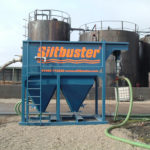Richard D. Coulton, Business Unit Manager (Construction) at Siltbuster explains why a suitable plan for managing water pollution is key to ensuring compliance.
The Environment Agency’s regulatory position statement (RPS) for the “Temporary Dewatering of Excavations to Surface Water” states that contractors must have a bespoke permit to discharge anything other than clean water offsite into the surrounding environment – be that to surface water, groundwater, coastal or estuary waters. In addition, penalties for water pollution offences have been increasing since the introduction of the Sentencing Council’s ‘Environmental Offences: Definitive Guideline’.
Given that most UK soils contain silts or clays, almost all construction projects have the potential to generate unclean wastewater. To avoid this, it is wise that decision-makers become more ‘water aware’ at the planning stage of projects.
Prevention
There are practical steps that firms can take to minimise silt pollution; most frequently generated when topsoil is stripped and surface runoff carries exposed soil particles to nearby drains and watercourses. These include only stripping the minimum area necessary, installing silt fences in areas to minimise scouring – worsened when surfaces are compacted by the use of heavy machinery – and digging cut off ditches to divert run-off from flowing through the site.
Hydrocarbons, such as petrol, diesel, kerosene and oils, can also pollute surface runoff. Historical spillages that have been absorbed into the land and unmapped pipe networks still full of product are the main sources of this kind of pollution, most commonly encountered on remediation projects. Again, there are measures firms can take to minimise the damage done, including providing oil spill kits and refuelling vehicles in designated areas where adequate spill prevention can be provided.
The final main source of pollution on construction sites is concrete wash water, which is highly alkaline. One measure that firms can adopt to better manage concrete wash water is to establish a designated washout area well away from drainage gullies, surface water drains and water bodies. This serves to contain slurry, solids and any liquids generated during the washing down of equipment which has come into contact with fresh concrete.
Even after implementing these measures, silty, oily and cementitious waters can still arise, especially during periods of heavy rainfall.
Solutions
Although silty water can be tankered offsite, this is often prohibitively expensive. As a result, it makes more economic sense to treat it onsite.
One solution is the construction of settlement lagoons. These will help with the management of suspended solids but do take up a lot of space on construction sites. Plus, these efforts may not work well in areas of geology with chalk and clay, due to the very fine particle sizes and poor settlement characteristics.
A more compact solution is to use lamella clarifiers which are up to 20 times more space efficient than traditional baffle tanks or lagoons. If the silty waters have fine slow settling particles, such as clays, a chemical dosing stage may also be required to aggregate the particles and increase the settlement rate. Such systems can be hired or purchased to work in conjunction with existing lagoons or with portable clarifiers.
In certain cases, such as site remediation projects, oil contaminated water may be hard to avoid and an oil water separator will be needed to remove the contamination. A floating hydrocarbon leaves a visually obvious rainbow sheen to water, whilst a denser contaminate such as creosote will simply sink to the bottom of a tank. Both can be easily separated from water by either flotation for contaminants with a lower density than water, or settlement for contaminants with a higher density than water.
However, if hydrocarbons are found to be in a dissolved phase, treatment is significantly more expensive, and typically achieved by absorbing the hydrocarbons onto carbon through the use of GAC vessels.
Care should be taken when working with free phase hydrocarbons as selection of the wrong sort of pump can emulsify the oils, making treatment harder and more expensive. A low sheer pump, such as a progressive cavity or diaphragm pump, is best suited to these applications.
Cementitious water is highly alkaline. In fact, its pH is between 12 and 13, which is equivalent to oven cleaner. This makes it highly damaging when discharged to the aquatic environment.
For cementitious waters, dilution isn’t a practical or cost-effective treatment method – it takes 10,000 litres of water to lower 1 litre of concrete wash water with a pH of 12 to an acceptable pH of eight. Mineral acids, such as sulphuric or hydrochloric acid, lower pH, but they are dangerous to handle, create secondary pollutants and are prone to overshooting the target resulting in equally polluting acidic water.
Treatment systems that incorporate carbon dioxide as a neutralising agent are cost-effective and most fit for purpose. The gas has no hazardous by-products, is easy to store and it’s virtually impossible to acidify water using it.
As you can see, there are some simple steps construction firms can take to both minimise the risk of creating onsite water problems and to deal with the problems should they arise. The key lesson is to be pre-emptive rather than reactive; to anticipate the problems, prepare for the unexpected and know what the solutions are – in essence, to plan.
To help companies comply with their water treatment consent permits, Siltbuster provides technical support, CPD accredited courses plus bespoke and tailored technical training days. Siltbuster also has an extensive range of systems to treat water pollution that can be used on projects of varying sizes.









